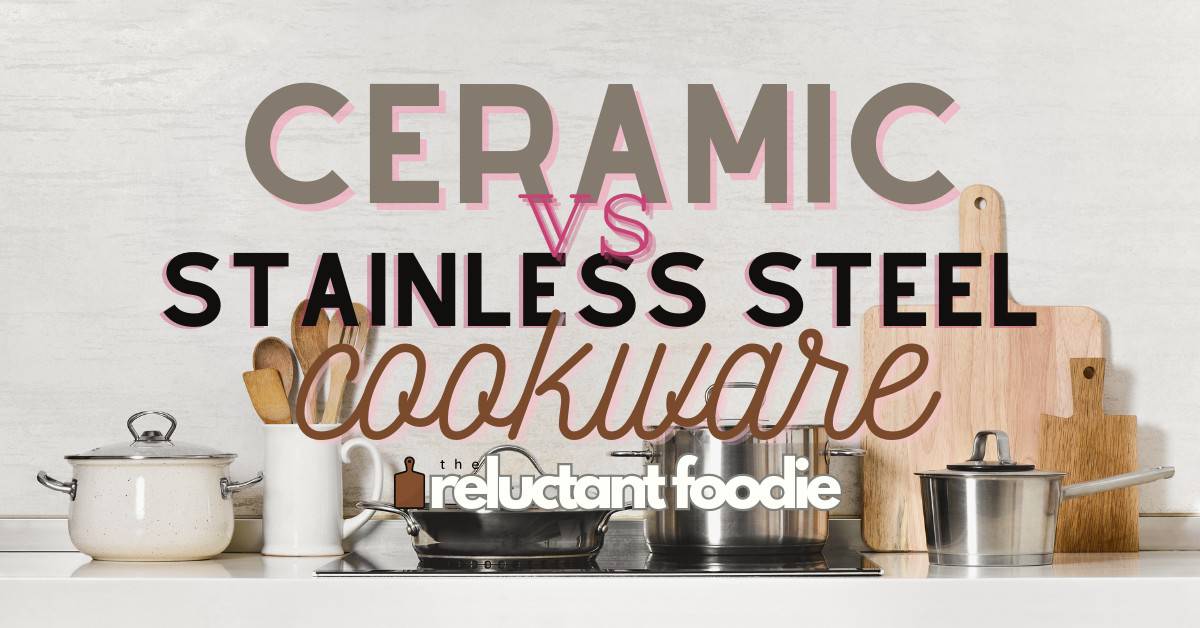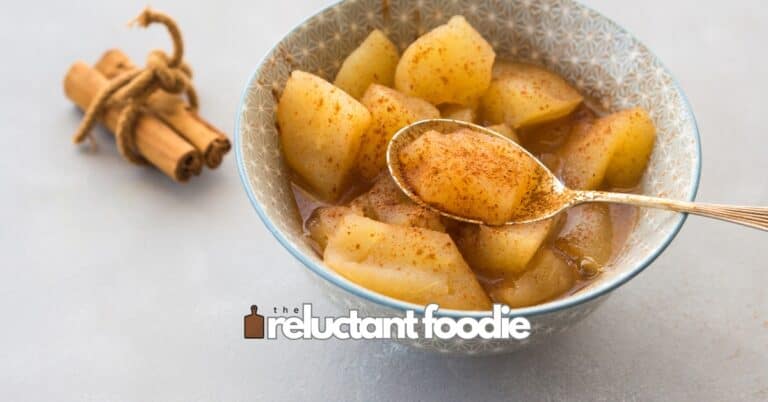Ceramic vs Stainless Steel Cookware: What’s The Best For You?
One of the things we do most often in our lives is cook. Nearly every day, someone in your house reaches for a pan to cook with.
Just a few years ago, I was crippled with chronic conditions and symptoms, and I found out that the simple pan I purchased, who knows how long ago, may have been making things much worse.
Think about it: if you knew toxins could be in your food because of your cookware, you would want only to use safe cookware, right? This is an absolute yes for me.
After many hours of researching the safest pans, it became clear that the front runners in safe cookware are ceramic and stainless steel. But which one is the best? The debate of ceramic vs stainless steel cookware began.
Let me show you what I’ve learned so you can save time, make an educated choice, and be on your way to safe and healthy cooking.
This article contains affiliate links. Clicking on these links and making a purchase, I may earn a small commission at no extra cost to you. Doing so helps keep this blog running, and I only recommend products or services I believe in. Visit my disclaimers page for more info.
Key Takeaways
- Ceramic cookware is lightweight, non-stick, and great for low to medium-heat cooking. Stainless steel is resilient and versatile, being best for high-temp cooking.
- Both are safe from harmful chemicals like PFOA/PTFE and offer a variety of price ranges depending on your budget.
- Ceramic cookware needs more care and replacement to remain safe; stainless steel can offer a lifetime guarantee.
- Ceramic cookware is better for low to fat-free cooking; stainless steel cookware needs oil.
- Choosing between ceramic or stainless steel comes down to personal preference & cooking style.
Why Do You Need Non-toxic Cookware?
Have you heard of Teflon cookware? In the 1960s, this industrial non-stick coating took kitchens by storm with easy-to-clean, heat-resistant Teflon pans that revolutionized cooking. Everyone wanted and had a Teflon-coated pan at some point.
Unfortunately, Teflon, also known as PTFE, and other non-stick chemicals like PFOA are dangerous to our health.
These harmful chemicals leach into our food and enter into the air we breathe as the pan heats, and can lead to multiple chronic symptoms and conditions. Scary stuff, right?
The good news is both ceramic and stainless steel cookware are safe to use and do not contain these toxins.
Unfortunately, stainless steel lacks the ease of non-stick. But it can become non-stick with practice and specific steps. I’ll get more into that later.
Ceramic vs Stainless Steel Cookware Side-by-Side Comparison
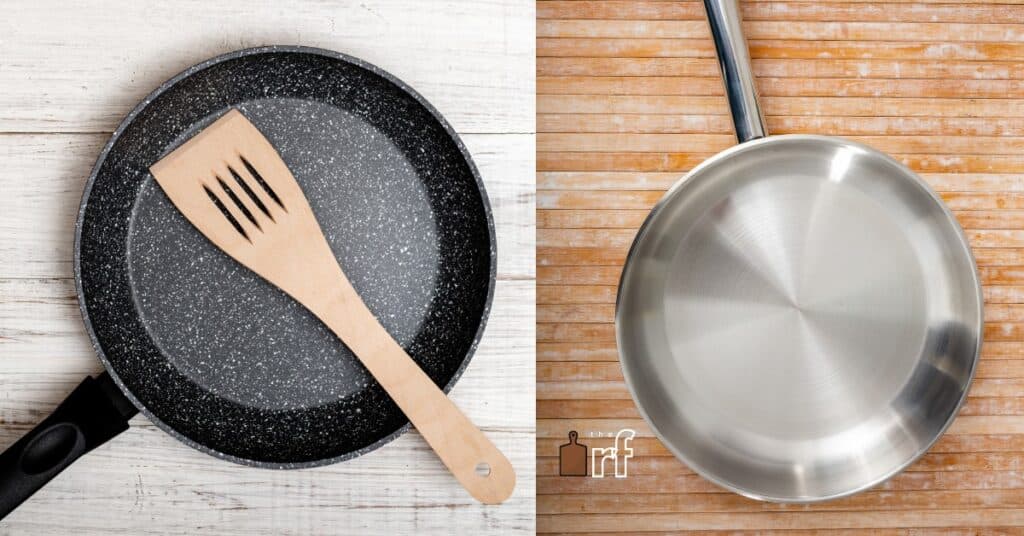
Let’s dive into things and see stainless steel vs ceramic cookware side-by-side over the most relevant categories you want to consider:
- Non-stick
- Durability
- Cleaning & Maintenance
- Healthy & Safety
- Versatility
- Budget
1. Non-Stick Performance
WINNER for Non-Stick Performance: CERAMIC
Ceramic: The ceramic coating is the go-to for non-stick with low to no oil. It will heat quickly at lower temperatures, so you don’t need to wait long to cook your food. The compromise is you rarely get a good sear on your food; darker caramelization is more challenging to obtain at these low temperatures (if at all).
And you should never use ceramic-coated cookware with high heat. Even if a ceramic pan is labeled oven-safe, I would avoid it. High temperatures will lessen the life of the pan and the nonstick quality.
Stainless Steel: Believe it or not, there is a hack to make a stainless steel pan non-stick; see the video below. Getting your stainless steel pan non-stick takes two things: patience and oil. For that gorgeous, flavorful steak you want, use stainless steel. If you are looking for non-fat cooking, you must avoid stainless steel. Always go for a high-quality, high-smoke point oil such as olive or avocado.
2. Durability And Longevity
WINNER for Durability & Longevity: STAINLESS STEEL
Ceramic: Typically, you must replace this cookware every 1-3 years. High-quality ceramic pieces can last several years, but you must take excellent care of them. And I mean perfect.
Use only wooden or silicone utensils on a ceramic pan to prevent scratches. Keep the heat below medium, do not clean in the dishwasher, and store them carefully (no stacking; separate all non-stick pans when storing to prevent scratches) to give yourself longevity with a ceramic coating.
Stainless Steel: If you’re looking for longevity, stainless steel is the winner. When taken care of properly, it can be a legacy you pass on to children. Metal cooking utensils are ok with stainless steel and won’t affect longevity.
3. Ease of Maintenance and Cleaning
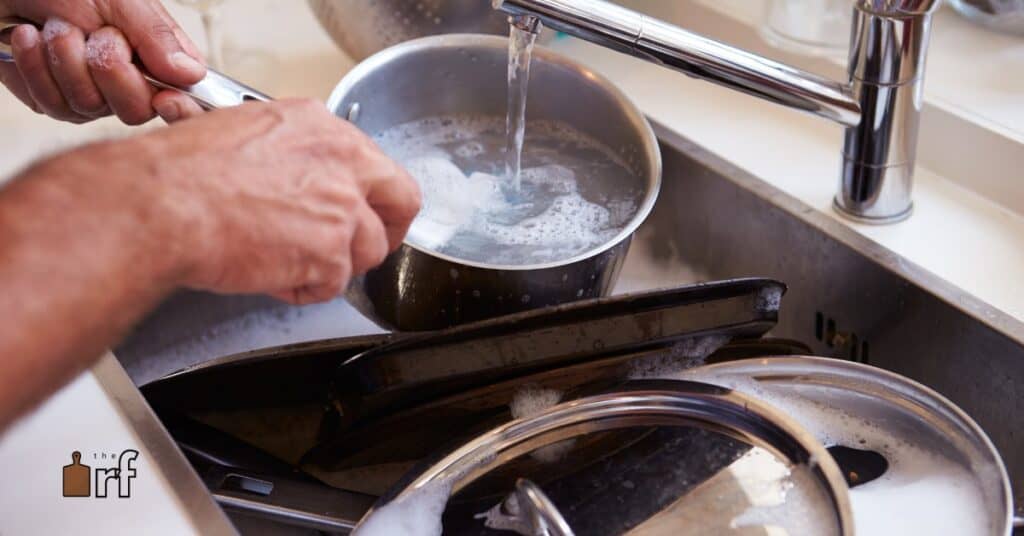
WINNER for Ease of Maintenance & Cleaning: CERAMIC
Ceramic: Cleaning ceramic cookware is usually a straightforward job. A quick wipe or washing with warm, soapy water can do the trick.
Stainless steel: Cleaning will take more effort because they’re not naturally non-stick. Many brands say dishwasher safe, but I don’t personally recommend it. Use a product like “bar keepers friend” or baking soda to remove discoloring.
Both: You must follow the instructions provided by the manufacturer. Don’t go rogue! And know that hand-washing will always beat placing them in the dishwasher. Keeping your pans safe and as long-lasting as possible is worth the extra few minutes.
Always let your pan cool before cleaning, and clean pans with warm water and dish soap.
4. Health and Safety Considerations
WINNER for Health & Safety Considerations: BOTH
Ceramic: There are a couple of potential safety concerns with ceramic non-stick cookware. Because it’s such a new technology, the effectiveness of ceramic coatings still needs investigation and testing. Also, not all ceramic cookware is the same. Some are not PTFE-free. You must be sure by reading the label and buying from a reputable brand.
The other concern with ceramic is when the surface gets scratched, it is no longer safe. You cannot use metal utensils on ceramic for this reason. If you see any scratches, you’ve got to replace them as soon as possible. Why? Because that scratch is now emitting toxins into your food and air. Most ceramic pans have a short guarantee.
A pro on the ceramic side is you can avoid cooking oils altogether, which is a healthier option. See my article on learning to Love to Cook Without Oil for tips on how easy cooking without oil can be.
Stainless Steel: the trustworthiness of stainless steel has been proven over time, making it an obvious favorite for many home cooks. If you are sensitive to nickel, you must look for nickel-free brands.
Stainless Steel requires high-quality cooking oil, which can be bad for your health if used in large amounts. You must also not burn cooking oil, which can cause health issues.
Both: Do not store food in either ceramic or stainless steel cookware.
5. Versatility and Cooking Applications
WINNER for Versatility & Cooking Applications: BOTH
Ceramic: This material is best and only recommended for low- or medium-temperature settings. It is excellent for nearly all foods. You can turn away from this cookware if you need to (not for long; always keep an eye on your food when cooking), which gives you a chance to prepare other courses simultaneously. Ceramic is also non-reactive, meaning it won’t affect the food flavor.
Stainless steel: Unlike ceramic, these can easily handle high heat and are oven-safe, which is best for cooking various meats. For recipes that call for you to finish the food in the oven, choose stainless, as stainless steel can provide better benefits in terms of strength and heat conduction properties.
6. Budget and Price Range
WINNER for Budget & Price Range: CERAMIC
Ceramic: For those working with a tight budget, ceramic cookware makes an excellent starter set that won’t break the bank. But know that you will need to replace these pans more often.
Stainless Steel: The stainless options are pricier but boast impressive durability and performance.
Top Brands and Recommendations
Here’s what my kitchen currently has: both ceramic and stainless steel pans. I buy my pans 1-2 at a time. Unless you start over, don’t feel you must get an entire set. I choose which pan to use based on my menu.
However, if you currently use toxic cookware, I recommend getting a new set of basics as soon as possible.
I have broken down my ceramic vs stainless steel cookware recommendations on sets by price range as well as my favorite stand-alone pans of each type that you may want to add to your current collection.
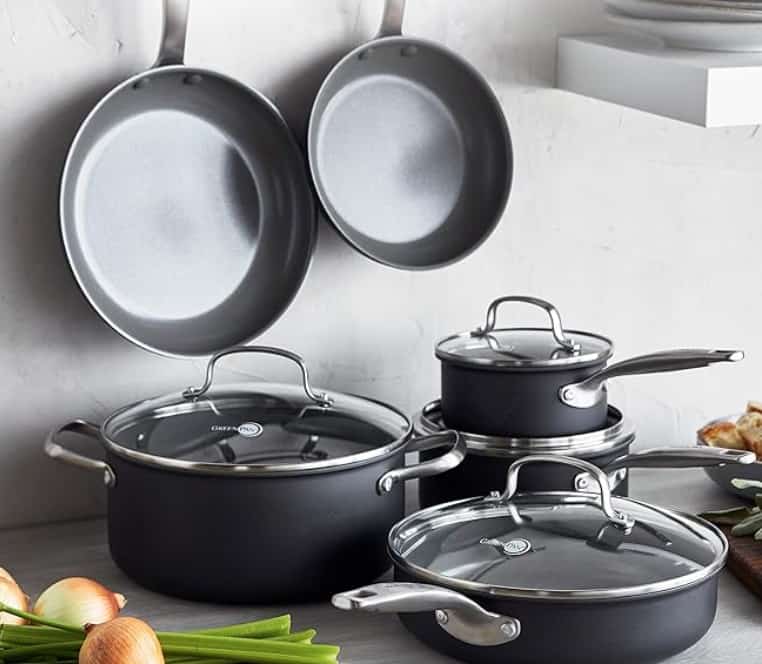
GreenPan Ceramic 10-Piece Cookware Set
- Oven and dishwasher-safe
- Hard anodized body
- Glass lids
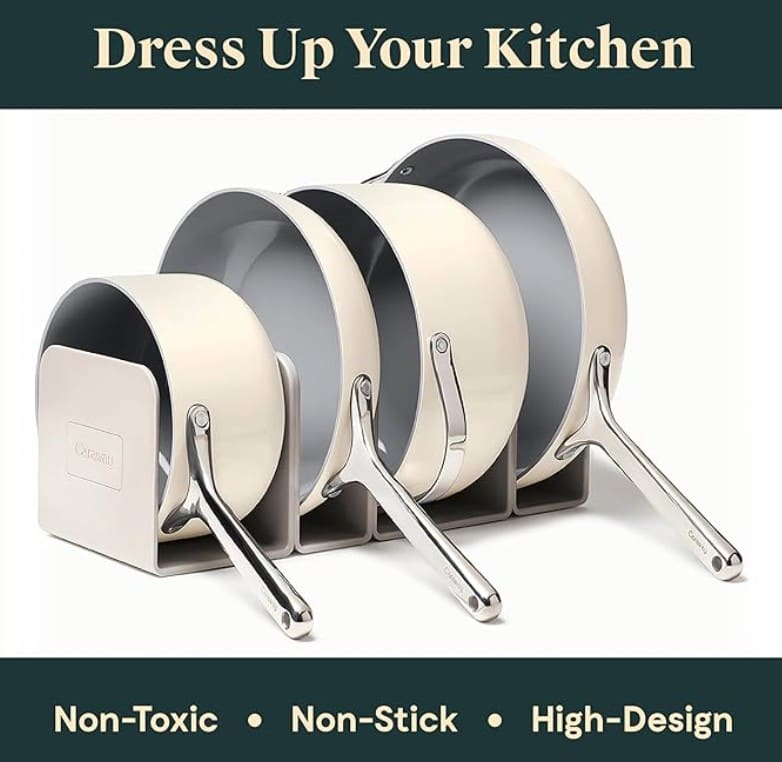
Caraway 12-Piece Ceramic Cookware Set
- Only the pieces you need
- Storage tray and lid holder
- Multiple colors
- Will last longer with care
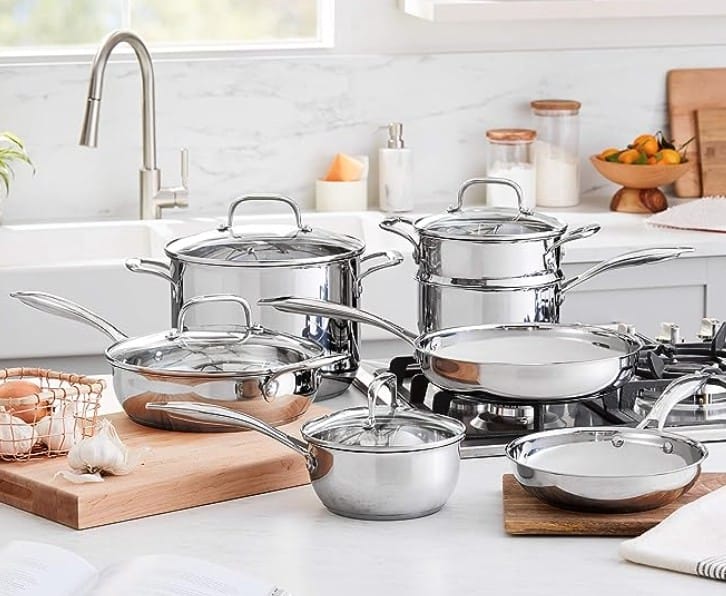
Amazon Basics Stainless Steel 11-Piece Cookware Set
- Evenly distributes heat
- Oven safe up to 500 degrees
- Glass lids with steam holes
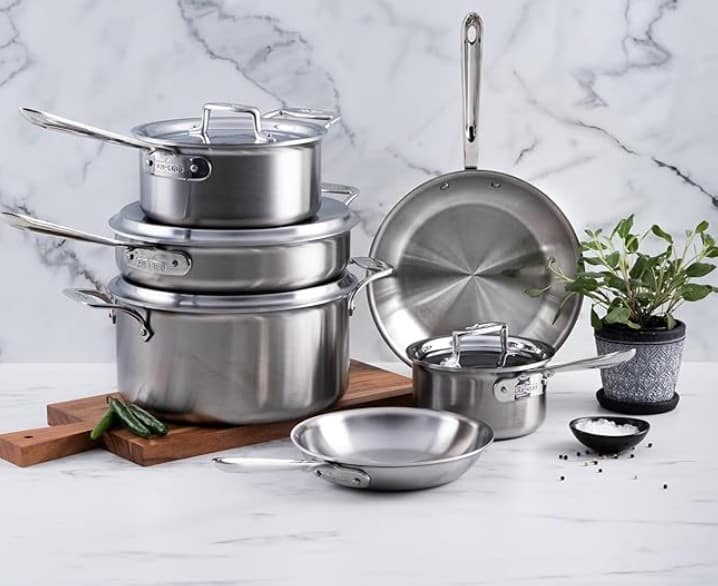
All-Clad 5-Ply Stainless Steel 10-Piece Set
- Made in the USA
- Superior quality
- Oven safe up to 600 degrees
- Lifetime warranty
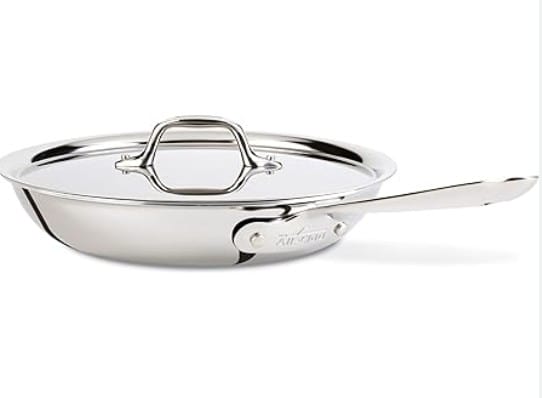
All-Clad Stainless Steel 10-Inch Pan
- Perfect for cooking steaks
- 3-ply bonded stainless steel
- Made in USA
- Lifetime warranty
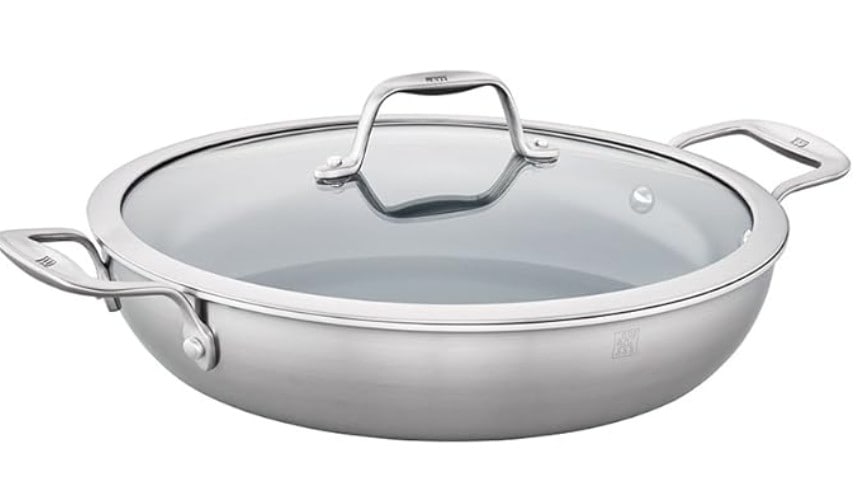
Zwilling Ceramic 4-Qt Braiser
- Aluminum core that heats quickly
- Stainless steel body
- Slick nonstick that is easy to clean
- Great for one-pan meals
Check out my Best Minimalist Kitchen Tools article for more healthy kitchen tools.
Understanding Ceramic Cookware
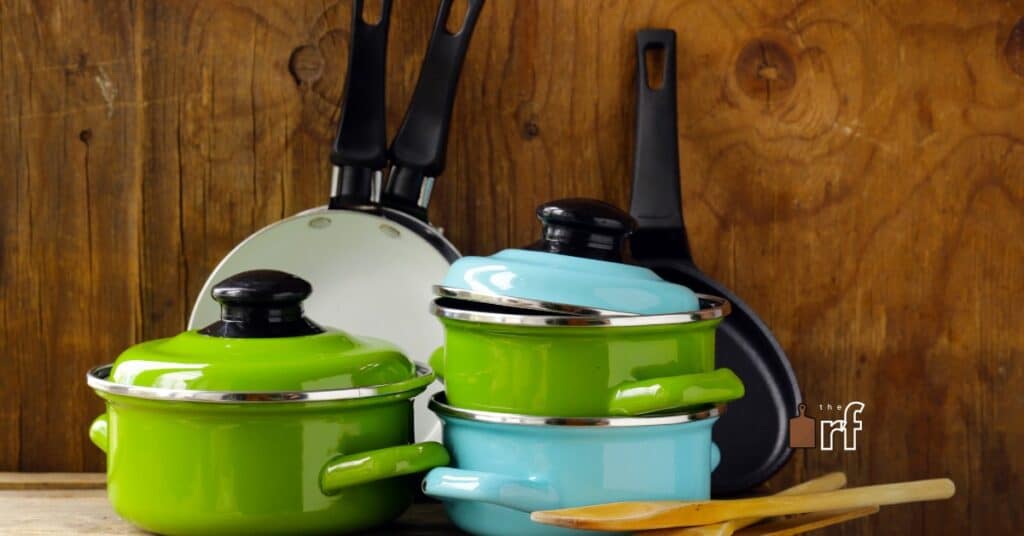
Ceramic cookware is the latest trend in cookware, and for good reason. It’s non-stick and easy to clean. You can use very little to no oil when cooking, which makes the food you cook healthier. And bonus: it comes in an array of colors.
What is Ceramic Cookware
There are two types of ceramic cookware:
- Pure Ceramic Cookware: made out of clay (think pottery), hardened and then coated
- Ceramic-coated Cookware: body made of various metals (most commonly aluminum) with a ceramic layer on the cooking surface
Is Ceramic Cookware Safe?
Ceramic cookware is, at minimum, PFOA-free, and many brands on the market boast of being PTFE (unlike Teflon), lead, and cadmium-free.
Understanding Stainless Steel Cookware
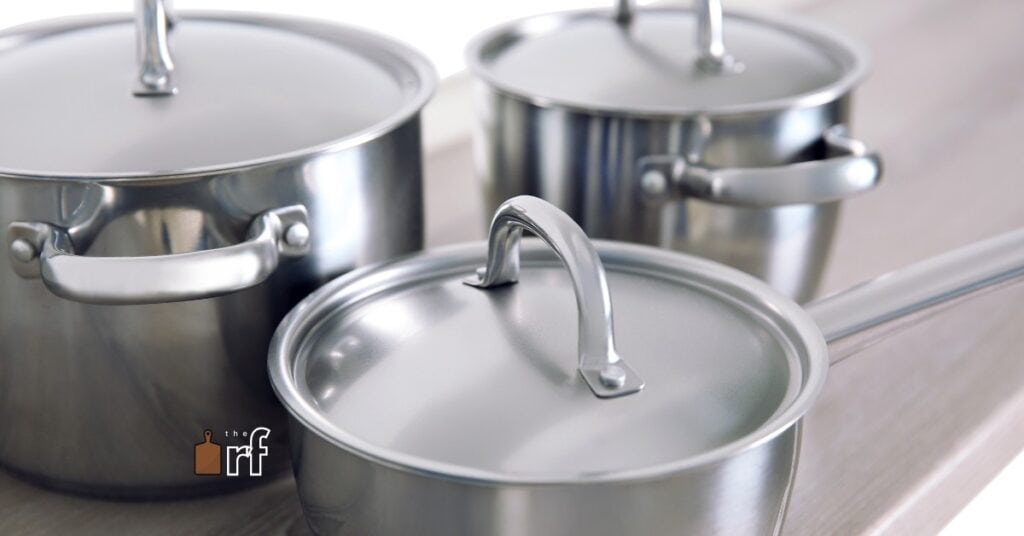
Stainless steel pans are what you see most professional chefs using. And although you can’t get trendy colors with stainless cookware, to me, they look gorgeous.
What is Stainless Steel Cookware?
Stainless steel cookware contains multiple layers of various metals with an aluminum core. They are incredibly long-lasting and can be used for high-heat cooking, giving meats that flavorful “sear” you see in restaurants and on cooking shows.
Is Stainless Steel Cookware Safe?
Like ceramic cookware, stainless steel pans are PTFE and PFOA-free. The only consideration is if you are sensitive to nickel and there are nickel-free brands out there. It also has one significant feature that beats ceramic pans: no nontoxic coating can be scratched off, making them incredibly long-lasting where safety is concerned.
Notes on other types of cookware
Here’s some quick notes about different types of cookware:
- Aluminum – Lightweight and efficient in heat distribution, aluminum cookware is generally safe, but prolonged use may release trace amounts of the metal into food. Aluminum exposure in cookware can lead to illness in some people.
- Hard anodized aluminum – Offering durability and scratch resistance, this cookware has a nonstick surface that is considered safe for cooking, with the anodization process preventing aluminum leaching. Replace immediately once scratched; see more on hard anodized cookware safety here.
- Cast Iron – Known for its ability to distribute heat evenly, cast iron cookware is safe and even adds a dose of dietary iron to your meals. It must be cared for properly to avoid rusting. A cast iron skillet is a favorite amongst steak lovers.
- Glass – Non-reactive and transparent glass cookware is safe for cooking and an excellent choice for those concerned about potential chemical reactions with food. Dishwasher safe.
- Stone – With natural non-stick properties, stone cookware is generally safe, but it’s crucial to follow care instructions to maintain its integrity over time.
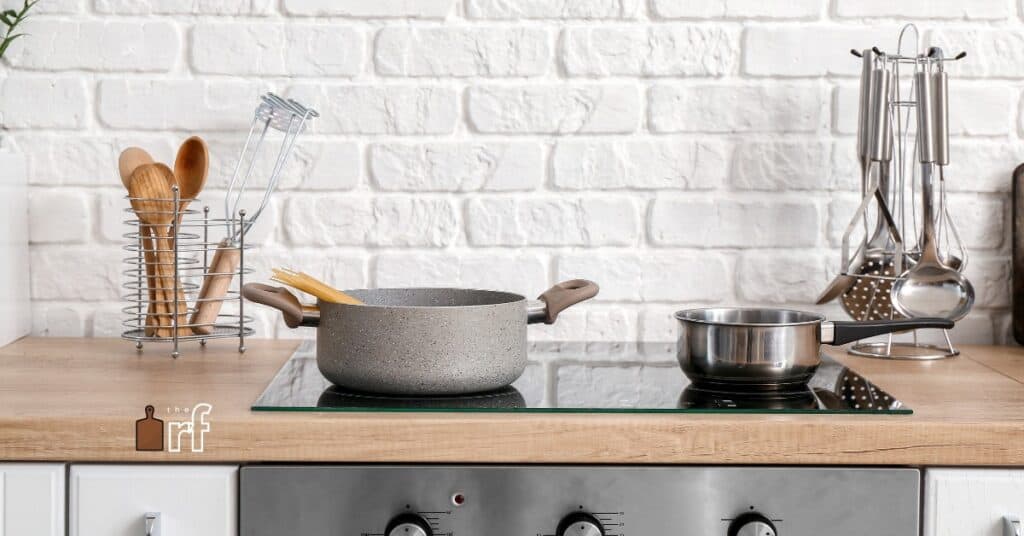
Summary
When it comes to the ceramic vs stainless steel cookware debate, ceramic and stainless steel cookware both have their pro’s and con’s. Both options are non-toxic.
Ceramic pans are ideal for low to medium-heat cooking and are less expensive. A ceramic pan is also perfect for low to no-fat cooking, which is better for your health. But you will have to replace ceramic pans every 1-3 years.
On the other hand, stainless steel cookware is awesome for high temperatures and getting that sear on a juicy steak. You’ll need practice and patience to make it nonstick, and they are more expensive. But stainless steel will last a lifetime and then some.
The right choice of pans for you will depend on your budget and preferred cooking style.
Frequently Asked Questions
Is it better to cook with stainless steel or ceramic?
When cooking, stainless steel cookware is the better choice due to its safety and lack of leaching any potentially hazardous chemicals into food. Although naturally non-stick, dangerous elements may be released if ceramic cookware becomes damaged or cracked. Consider multiple factors when deciding on a cookware type (safety and quality).
What is the healthiest cookware?
When cooking, the safest materials are stainless steel, ceramic, glass, and cast iron cookware so that no undesirable ingredients get into your food.
What are the disadvantages of stainless steel?
Stainless steel cookware has a downside. Its lack of a coated, non-stick surface makes it more of a challenge. It’s also typically more expensive than different types of cookware.
What are the disadvantages of ceramic cookware?
Ceramic cookware doesn’t last long and is unsafe if scratched. The long-term effects of the ceramic coating are still under investigation.

